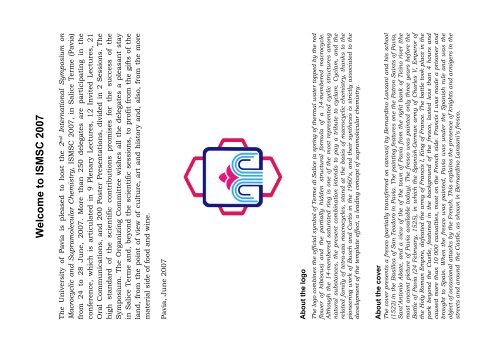ISMSC 2007 - Università degli Studi di Pavia
ISMSC 2007 - Università degli Studi di Pavia
ISMSC 2007 - Università degli Studi di Pavia
You also want an ePaper? Increase the reach of your titles
YUMPU automatically turns print PDFs into web optimized ePapers that Google loves.
Welcome to <strong>ISMSC</strong> <strong>2007</strong><br />
The University of <strong>Pavia</strong> is pleased to host the 2nd International Symposium on<br />
Macrocyclic and Supramolecular Chemistry, <strong>ISMSC</strong> <strong>2007</strong>, in Salice Terme (<strong>Pavia</strong>)<br />
from 24 to 28 June, <strong>2007</strong>. More than 250 delegates are participating in the<br />
conference, which is articulated in 9 Plenary Lectures, 12 Invited Lectures, 21<br />
Oral Communications, and 200 Poster Presentations, <strong>di</strong>vided in 2 Sessions. The<br />
high standard of the scientific contributions promises for the success of the<br />
Symposium. The Organizing Committee wishes all the delegates a pleasant stay<br />
in Salice Terme and, beyond the scientific sessions, to profit from the gifts of the<br />
land, from the point of view of culture, art and history and, also, from the more<br />
material side of food and wine.<br />
<strong>Pavia</strong>, June <strong>2007</strong><br />
About the logo<br />
The logo combines the official symbol of Terme <strong>di</strong> Salice (a spring of thermal water topped by the red<br />
flower of hibiscus) and the partially hidden structural formula of a 14-membered macrocycle.<br />
Although the 14-membered saturated ring is one of the most represented cyclic structures among<br />
natural substances, the present combination intends to pay a tribute to cyclam. Cyclam, and the<br />
related family of tetra-aza macrocycles, stand at the basis of macrocyclic chemistry, thanks to the<br />
pioneering work of Busch and Curtis in the 1960's, and their synthesis is strictly associated to the<br />
development of the template effect, a lea<strong>di</strong>ng concept of supramolecular chemistry.<br />
About the cover<br />
The cover presents a fresco (partially transferred on canvas) by Bernar<strong>di</strong>no Lanzani and his school<br />
(1522) in the Basilica of San Teodoro in <strong>Pavia</strong>. The painting features one the Patron Saints of <strong>Pavia</strong>,<br />
Sant’Antonio Abate, and a view of the of the town of <strong>Pavia</strong> from the right bank of Ticino river (the<br />
most ancient picture of <strong>Pavia</strong> available today). The fresco was painted only three years before the<br />
Battle of <strong>Pavia</strong> (24 February, 1525), in which the Spanish-German army of Charles V, Emperor of<br />
the Holy Roman Empire, defeated the army of Francis I, King of France. The battle took place in the<br />
park beyond the Castle, featured in the background of the fresco, lasted less than 4 hours and<br />
caused more than 10 000 casualties, most on the French side. Francis I was made a prisoner and<br />
brought to Spain. When the fresco was painted, <strong>Pavia</strong> was under the Spanish rule and was the<br />
object of occasional attacks by the French. This explains the presence of knights and armigers in the<br />
streets and around the Castle, as shown in Bernar<strong>di</strong>no Lanzani’s fresco.

















